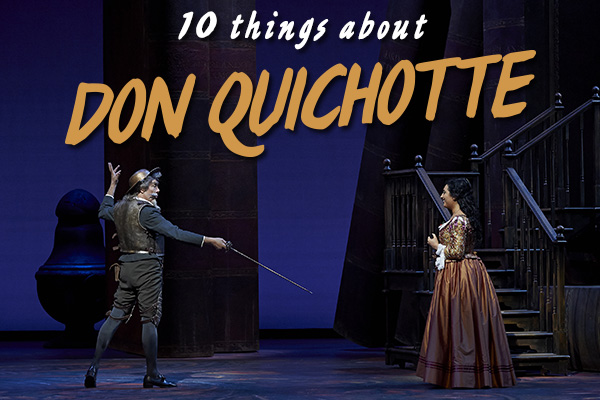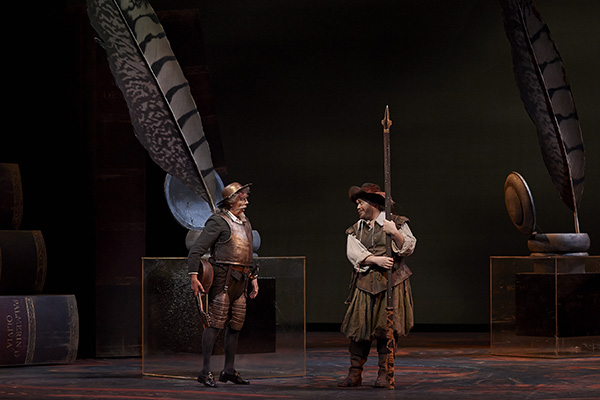-
10 Things to Know About Jules Massenet’s Don Quichotte
By Danielle D'OrnellasPosted in Don QuichotteBy Nikita Gourski, Development Communications Officer

Our final opera of the 2013/2014 season is the COC premiere of Massenet's rare opera, Don Quichotte! Learn more about the production history, cast and crew below.
1) The first novel
Published in two parts, in 1605 and 1615, Miguel de Cervantes’ Don Quixote is arguably the first novel ever written. The plot deals with the adventures of an elderly Spanish gentleman who has been reading too many tales of medieval chivalry and declares himself a “knight errant.” He begins travelling throughout Spain with his sidekick, Sancho Panza, in order to right all wrongs and seek fame and honour.2) Novel to play to opera
Cervantes’ novel has inspired adaptations, interpretations and homages across many different art forms. In 1904, Raoul Gunsbourg, the director of the Opéra de Monte Carlo, attended the opening night of a new play called Le chevalier de la longue figure (The knight of the long face) and liked the compressed, reinterpreted version of Cervantes’ novel so much he commissioned composer Jules Massenet to turn it into an opera, which subsequently premiered in Monte Carlo in 1910.3) Lost and found
Jules Massenet was born on May 12, 1842 in Montaud, France. He started receiving piano lessons from his mother at a young age and, by 11, had been accepted into the Paris Conservatory where he impressed his teachers with his musicianship and work ethic. He travelled to Italy in his 20s, exploring the cultural and artistic charms of the Mediterranean, but returned to France a few years later. Eventually he secured a professorship at the Paris Conservatory and composed 25 operas over the course of his life. Though Massenet’s works were quite popular in his lifetime, they suffered a subsequent neglect in the 20th century. In recent years, however, a new-found appreciation has emerged for a number of Massenet’s operas, including Don Quichotte.4) An intimate opera
For Don Quichotte, Massenet was working in an intimate compositional mode, somewhat like chamber music. Although he could write operas requiring huge orchestral and choral forces, he was able to downsize all of this in the interest of telling Don Quichotte’s more intimate, personal story. Much of its score is lightly orchestrated, accompanied by solo instruments such as the guitar; or, by solo instrumental sections (for example, cellos dominate Don Quichotte’s death scene). Listen to musical excerpts with our Listening Guide.
5) The fantastic Furlanetto
This production marks the COC debut for Italian bass Ferruccio Furlanetto, whose legendary 40-year career has established him as one of the greatest singing actors of his generation and the leading interpreter of Don Quichotte.“Quichotte is eternally compelling because he is what every man should be… a man full of humanity, love, tenderness and appreciation for life.” Ferruccio Furlanetto
6) Linda Brovsky directs
American Linda Brovsky has worked extensively throughout North America as an opera and musical theatre director, writer and lecturer. Don Quichotte, a production originally created for Seattle Opera, marks her COC debut.7) Love letter to literature
The sets designed by Donald Eastman are comprised of enormous books and quills and also feature projections that tower above the stage and replicate pages of Cervantes’ manuscript. In different configurations, the books can evoke a mountainside, or a bandit camp, thereby highlighting the profound connection between literature and the human imagination, as well as the very spirit that animates Don Quixote’s dream-like adventuring.8) ¡Flamenco!
Complementing Massenet’s distinctive, Spanish-inspired melodies on stage are classical Flamenco dancers. Drawn mainly from local Toronto dancers, the performers also feature veteran Mexican flamenco star Raúl Salcedo and are led by master choreographer Sara de Luis.9) Four-legged friends
Director Linda Brovsky has opted to use a live horse and donkey on stage, noting that the animals are integral characters in the story and their effect would be diminished with prop stand-ins. To ensure mutual comfort during live performances, the singers must bond with the animals during the rehearsal period, working to establish a relationship that has both the singer and the animal knowing and trusting each other.10) In the lobby
For the duration of the opera’s run (May 9 – 24) we’re delighted to welcome a multi-part installation by Toronto artist Mitchell F. Chan into the opera house. Chan’s project explores the intangibility of truth with several elements located throughout the house, anchored by a large water vapour installation (on the main level) that spells out, letter by vanishing letter, the entirety of Cervantes’ novel. The art work thus dematerializes the novel’s content, while all at once affirming Cervantes’ central metaphor: truth is ephemeral. Chan’s pieces share the house with another Quichotte-themed display, this one at the Opera Shop, showing three authentic photographs of Feodor Chaliapin, the legendary Russian bass who originated the title role of Massenet’s opera.Don Quichotte runs from May 9 to 24 at the Four Seasons Centre for the Performing Arts. For tickets and more information click here.
Photos: (top) Ferruccio Furlanetto as Don Quichotte and Anita Rachvelishvili as Dulcinée; (middle) Ferruccio Furlanetto as Don Quichotte and Quinn Kelsey as Sancho Panza in the Canadian Opera Company production of Don Quichotte, 2014. Photos: Michael Cooper
